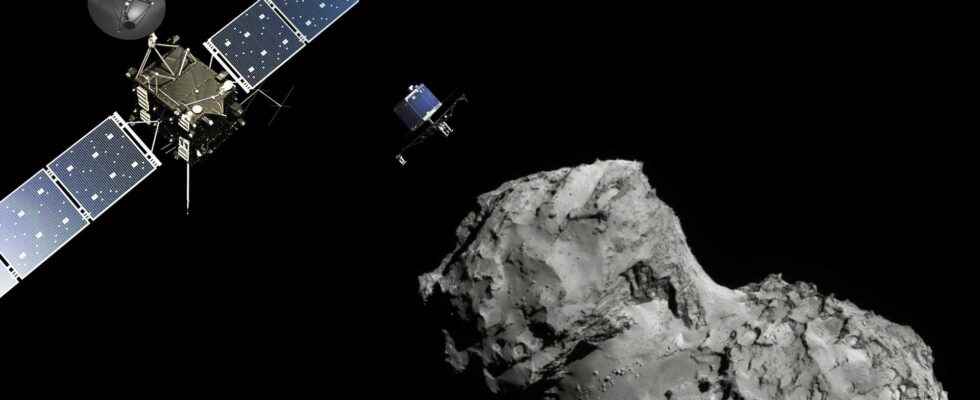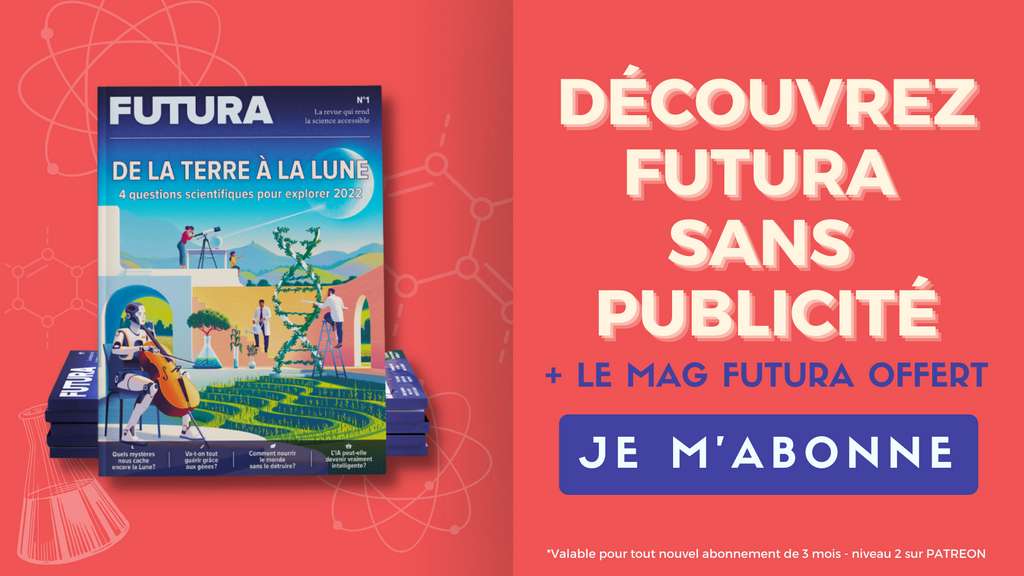In his major opus, The Human Phenomenongreat paleontologist, geologist and philosopher Teilhard de Chardin asserted that ” the history of the Living World comes down to the elaboration ofeyes always more perfect within a Cosmos where it is possible to discern more and more “. This sentence resonates with the Rosetta mission of theESA which gave us spectacular images of the surface and the activity of comet 67P/Churyumov-Gerasimenko, a.k.a Tchouri, which had been discovered by two Ukrainian astronomers. Their observations led to the determination that it was a short-period comet in an orbit that takes it around the Sun in 6.5 years: its aphelion (the point of its orbit farthest from the Sun) being located beyond the orbit of Jupiter and sound perihelion (the closest point to the Sun) between those of Mars and Earth. But it was the close observations of the Rosetta probe that established that the comet had a core of about 4.3 km by 4.1 km.
After reaching the comet in August 2014, Rosetta orbited this “dirty snowball” that cosmogonists consider a record of the formation of the planet. Solar systemformed in the cold regions of the protoplanetary disk where were born at the same time asteroids and planets about 4.5 billion years ago.
Rosetta followed for two years all the activity of the comet as it approached the Sun before moving away from it, emitting during this period of the matter sublimated by the hot rays of the Sun, until completing its mission by descending on the surface of the comet on September 30, 2016.
Three years after the official end of the Rosetta mission in 2016, scientists gathered at ESA’s Estec facility in the Netherlands to discuss the latest findings at the final Science Task Team (SWT) meeting ). The mission produced an enormous amount of data that will keep many scientists busy for years. For example, the Osiris camera took 100,000 images. To obtain a fairly accurate French translation, click on the white rectangle at the bottom right. The English subtitles should then appear. Then click on the nut to the right of the rectangle, then on “Subtitles” and finally on “Translate automatically”. Choose “French”. © European Space AgencyESA
The data collected during the mission makes Tchouri the best-studied comet of all time and it is still being analyzed. There are in particular the images taken from different angles and under different illuminations by the instrument called Osiris– some are embossed. These images are from a resolution exceptional because each pixel represents a detail less than approximately 1 m. The astronomers had already been able to realize thanks to these images that in two years thousands of changes on a scale of 1 to 10 meters, such as the formation of small pits, impact craters and rolling and bouncing rocks, were already well detectable. But today ESA wants to do better by using the fact that some of the unique capabilities of the brain human in the recognition of images still escape theArtificial intelligence.
A new example of citizen science with Zooniverse
The problem the researchers want to solve is the following. Admittedly, the comets are believed to be memories of the initial chemical composition and physical processes in the protoplanetary disk. However, in the case of comets like Tchouri which return to their perihelion in less than 10 years, the repeated heating of its surface and other processes at work during its orbital journeys cause its surface to evolve, so that really useful data to decipher the mysteries of the primitive cosmogony of comets and therefore of the Solar System, even of chemistry prebiotic more than 4 billion years ago at the origin of life on earthare noisy and polluted so to speak by these phenomena.
It is therefore necessary to be able to model and understand this noise correctly in order to subtract it from the data and go back to the information sought. That’s why ESA wants to use the images taken at various times in Rosetta’s orbits around Tchouri to map and log the transformations of its surface.
One might think that the techniques of machine learning could make it possible to automate the creation of these processing of information in the images of Osiris but, since they were taken under different angles and illuminations for the same region during two years, the task turns out to be more difficult than one might naively think so at first glance. But this is not the case for a human brain, and even better, for a collection of human brains from the noosphere connected by the Arthur Clarke’s WWW.
A statement from the ESA therefore invites all Internet users who wish to connect to the site. Rosetta Zoo which is part of gate citizen science zoouniverseextension of the original project Galaxy Zoo which invited Internet users to rank the galaxies. Futura has already devoted several articles to this portal, which gives everyone the opportunity to put themselves in the shoes of a researcher on the cutting edge of research by becoming, for example:
The ESA press release explains that ” the rosetta zoo features pairs of images collected by Rosetta’s Osiris Camera showing the surface of comet 67P as it approached and receded from the Sun. Volunteers are asked to view side-by-side images of roughly the same region and identify a variety of changes, from large-scale dust transport to comet pieces that have shifted or even disappeared. Sometimes this may require zooming in or out a few times, or rotating the images to spot changes at different scales…
Anyone can use Rosetta Zoo online for free, without needing to register, install any app or program, or have prior scientific experience
Through visual inspection by many volunteers, the project will produce maps of the changes and active areas on the comet’s surface, with labels for each type of change. Scientists will then be able to link the comet’s activity to changes on its surface, developing new models to link the physics of cometary activity to observed changes such as heaving rocks or collapsing cliffs.
Anyone can use Rosetta Zoo online for free, without the need to register, install a application or program, or to have prior scientific experience “.
This is not the first time that Internet users have been invited to produce participatory scientific knowledge about comets. We remember in particular a decade ago the project Stardust@home.
Right now, receive the Mag Futura for free by subscribing to our subscriptions!
Did you know that you can access Futura without ads via our subscriptions?
At the moment, you can discover this advantage with our special offer: subscribe to the “I participate in the life of Futura” (for a minimum of 3 months) and receive the Mag Futura at home* (worth €19)!
*Mag Futura is sent after the third month of registration.
Interested in what you just read?

